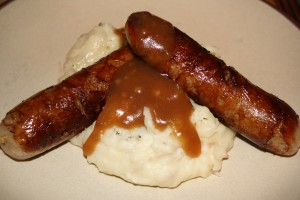On March 17, many Americans and their European counterparts will be celebrating Saint Patrick’s Day. On this particular day, I tend to visit a pub or two and partake in the food and as well as the lively company.
Over the years, several Irish dishes that have grown in popularity include Guinness lamb stew with soda bread, seafood boxtys (seafood stew served on a thin potato pancake), colcannan or champ (mashed cabbage or green onions and potatoes), coddle (a simple, slow-cooked stew made from pork, sausages, potatoes and onions), Irish boiled dinner (corned beef and cabbage), and, my favorite, bangers and mash.
Bangers and mash are simply a course ground pork or beef sausage served with mashed potatoes. The sausage earned its moniker of “banger” from the noise the sausage casings make while popping or making a bang as they cooked.
Making bangers and mash can be a simple or complex task. Course ground sausages can be bought at a store and serve with regular mashed potatoes, but, as a traditionalist, I thought I would provide a recipe to make bangers and champ at home. 
Banger Ingredients:
1/2 pound ground lean pork
1/2 pound ground lean veal
6 ounces ground pork fat
3 slices white bread with crust, crumbled or finely chopped
1 tsp salt
1/4 tsp black pepper
1/4 tsp cayenne pepper
1/8 tsp mixed grated nutmeg
1/8 tsp mace
1/4 tsp minced fresh thyme or 1/8 tsp dried thyme
1/4 tsp minced fresh marjoram or 1/8 tsp dried marjoram
2 tsp minced fresh sage or 1 tsp dried sage
1 tsp loosely packed, finely grated lemon zest (see Note)
1 large egg
Prepared hog or gelatin casings
Preparation:
Combine ground pork, ground veal, pork fat, and bread.
Whisk together salt, pepper, cayenne pepper, nutmeg, mace, thyme, marjoram, sage, lemon zest, and egg.
Knead into pork and veal mixture
Stuff sausage mixture into prepared the casings, compacting the sausage firmly. Prick any air pockets with a pin.
Bangers may be poached, braised or fried. Raw sausages will keep up to three days in the refrigerator and 3 months in a freezer. Cooked sausages may be refrigerated up to 1 week or frozen up to 3 months. While they are cooking, the mashed potatoes, champ, or colcannon can be made. To make colcannon, follow the same recipe below, but substitute green cabbage for the green onion.
Champ Ingredients:
4 pounds potatoes
1/2 pint whole milk or cream
1 cup chopped green onions
1/2 cup butter
Salt and black pepper to taste
Preparation:
Thoroughly wash the potato skins and cut the potatoes into medium sized cubes. If you do not like the potato skins in your mash, peel your potatoes before cooking them in boiling water until tender.
Simmer milk and spring onions together for five minutes. Once tender, drain potatoes, add the hot milk with the spring onions, salt and pepper, and half of the butter.
The banger recipe will yield 2 pounds raw sausage
The champ recipe will yield 8 servings
To serve in the traditional manner, the champ or mashed potatoes would be placed on the plate first and the sausages would be served on top. Depending on your tastes, I have seen this dish served plain, with onion or sausage gravy, and/or with horseradish. In the photograph, I’ve prepared gravy from the rendered fat from the bangers.
Bainigí sult as an bia! (“Enjoy the food” in Gaelic)


